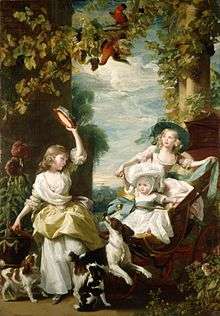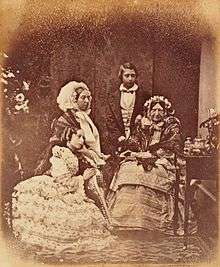Princess Mary, Duchess of Gloucester and Edinburgh
| Princess Mary | |
|---|---|
| Duchess of Gloucester and Edinburgh | |
 | |
| Born |
25 April 1776 Buckingham Palace, London, England |
| Died |
30 April 1857 (aged 81) Gloucester House, London |
| Burial |
8 May 1857 St George's Chapel, Windsor |
| Spouse | Prince William Frederick, Duke of Gloucester and Edinburgh |
| House | Hanover |
| Father | George III of Great Britain |
| Mother | Charlotte of Mecklenburg-Strelitz |
Princess Mary, Duchess of Gloucester and Edinburgh (25 April 1776 – 30 April 1857) was the 11th child and 4th daughter of King George III of the United Kingdom.
She married her first cousin, Prince William Frederick, Duke of Gloucester and Edinburgh, when both were 40, and was his widow in later life. In her last years, her niece Victoria was on the throne as the fourth monarch during Mary's life, after her father and two of her brothers. Princess Mary was the longest-lived (at 81 years) and last survivor of George III's fifteen children; of those fifteen issue, thirteen lived to adulthood. She was also the only one of George III's children to be photographed. She died on 30 April 1857 at Gloucester House, London.
Early life
Princess Mary was born, on 25 April 1776, at Buckingham Palace, London. Her father was the reigning British monarch, George III. Her mother was Queen Charlotte, the daughter of Charles, reigning Duke of Mecklenburg-Strelitz.

Mary was christened on 19 May 1776, in the Great Council Chamber at St. James's Palace, by Frederick Cornwallis, The Archbishop of Canterbury. Her godparents were:
- Landgrave Frederick of Hesse-Cassel (her first cousin once-removed, for whom The Earl of Hertford, Lord Chamberlain stood proxy)
- The Duchess of Saxe-Gotha-Altenburg (wife of her first cousin once-removed, for whom The Duchess of Argyll, Lady of the Bedchamber to The Queen, was proxy)
- Princess Charles of Mecklenburg-Strelitz (her third cousin once-removed, for whom The Dowager Countess of Effingham, Lady of the Bedchamber to The Queen, stood proxy).[1]


According to author and historian Flora Fraser, Mary was considered to be the most beautiful daughter of George III. Mary danced a minuet for the first time in public at the age of sixteen in June 1791, during a court ball given for the king's birthday.[2] In the spring of 1792 she officially debuted at court.[2] Around 1796 Mary fell in love with the Dutch Prince Frederick, while he and his family lived in exile in London. Frederik was a son of William V, Prince of Orange, the Dutch stadholder, and younger brother to the future King William I of the Netherlands. However Frederik and Mary never wed because George III stipulated that her elder sisters should marry first. In 1799 Prince Frederik died of an infection while serving in the army, and Mary was allowed to go into official mourning.
Mary's youngest sister and beloved companion Princess Amelia called her "Mama's tool" because of her obedient nature. Amelia's premature death in 1810 devastated her sister, who had nursed her devotedly during her painful illness.
Marriage
Mary's upbringing was very sheltered and she spent most of her time with her parents and sisters. King George and Queen Charlotte were keen to shelter their children, particularly the girls. Mary, however, married on 22 July 1816, to her first cousin, Prince William Frederick, Duke of Gloucester and Edinburgh, the son of George III's brother, Prince William Henry, Duke of Gloucester and Edinburgh, at the Chapel Royal in St James's Palace. On their wedding day, Mary's brother, The Prince Regent, raised the bridegroom's style from Highness to Royal Highness, an attribute to which Mary's rank as daughter of the King already entitled her.
The couple lived at Bagshot Park, but after William's death she moved to White Lodge in Richmond Park. They had no children together. Princess Mary was said to be the favourite aunt of her niece, Queen Victoria.
Princess Mary was quite close to her eldest brother, and she shared his dislike toward his wife, their cousin Caroline of Brunswick. When the latter left for Italy, Princess Mary congratulated her brother "on the prospect of a good riddance. Heaven grant that she may not return again and that we may never see more of her."[3]
Titles, styles and arms
Titles and styles
- 25 April 1776 – 22 July 1816: Her Royal Highness The Princess Mary
- 22 July 1816 – 30 November 1834: Her Royal Highness The Duchess of Gloucester and Edinburgh
- 30 November 1834 – 30 April 1857: Her Royal Highness The Dowager Duchess of Gloucester and Edinburgh
Arms
As of 1789, as a daughter of the sovereign, Mary had use of the arms of the kingdom, differenced by a label argent of three points, the centre point bearing a rose gules, the outer points each bearing a canton gules.[4]
Ancestors
See also
References
- ↑ Yvonne's Royalty Home Page: Royal Christenings
- 1 2 Lane, Henry M. (1911). The Royal Daughters of England. London. p. 191.
- ↑ John van der Kiste: George III's Children, p. 106
- ↑ Marks of Cadency in the British Royal Family
External links
- "Archival material relating to Princess Mary, Duchess of Gloucester and Edinburgh". UK National Archives.